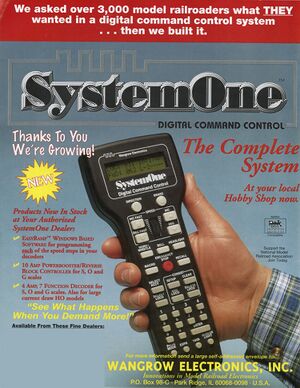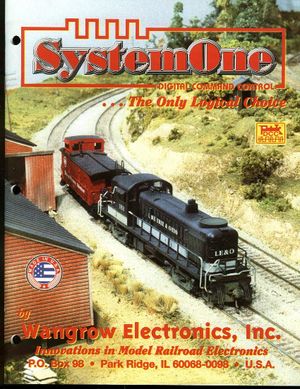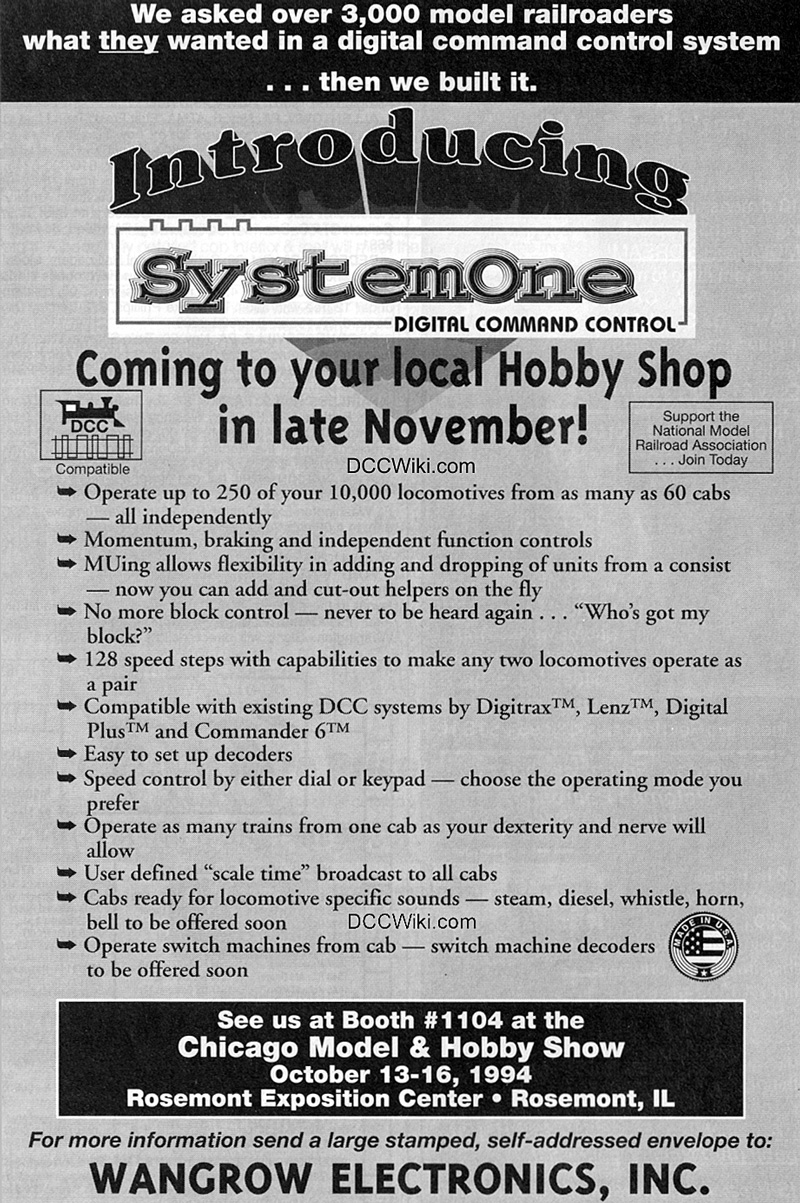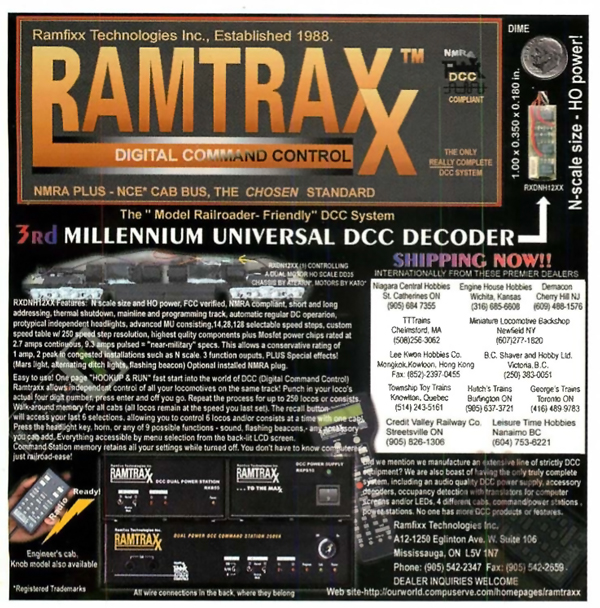Wangrow
Manufacturer: Wangrow
| This manufacturer has been closed since 2003 |
Summary: Wangrow Electronics was an early entrant producing DCC systems.
| See more Manufacturers | |
|---|---|

| |
| General information | |
| Phone | |
| Fax | |
| CV8 ID# | 12 |
| Main URL | |
| URL to manuals | |
| Address | |
| Date Opened | 1994 |
| Date Closed | 2003 |
| Successor | |
| Device Types | Booster, Command Station, Mobile Decoder, Stationary Decoder, Throttle |
History
The Wangrow SystemOne, an early Digital Command Control system, shipped in late 1994, retailing for $879. Wangrow Electronics ceased trading and was dissolved in 2003 after the death of founder Don Wangrow.
Wangrow Electronics
Wangrow Electronics Inc. founder, Don Wangrow, passed away in June 2003. Wangrow Electronics ceased trading and was dissolved that year. The Wangrow SystemOne shipped in late 1994, retailing for $879. In 1995 Wangrow announced a 4A seven function decoder for large scale locomotives. While it has reached end-of-life and is no longer supported, the Wangrow SystemOne is still a good system for those looking for a DCC system. It was a full-featured product in its time, and is still useful. Even used, they are still a good buy.
Manufacturer ID
These ID codes are issued by the NMRA. For more information, see Manufacturer ID.
- Wangrow = 12
- Ramfixx = 15
Wangrow Electronics SystemOne
The SystemOne Digital Command Control system was also known as the SYS1.
The SystemOne was originally designed by a third-party contractor which also manufactured the hardware. Software was supplied by NCE, which would also supply some of the hardware designs, such as the command station. The dual booster, MasterCab/Procab throttles and decoders were designed by a contractor, as was the cab bus using a 1/4" phone plug. Another manufacturer designed and supplied accessory decoders.
Wangrow began shipping their SystemOne (SYS1) systems in December 1994.
The SystemOne was introduced at the Chicago Model and Hobby Show i October 1994. [1]
Wangrow claimed the following was possible:
- Operate as many as 250 out of 10,000 locomotives with up to 60 cabs
- Momentum, braking and independent function controls
- Mu Consisting, with the ability to add and remove power "on the fly"
- 128 Speed Steps, with speed curves
- Easy Decoder Setup
- Cabs offer dial or keypad for speed control
- Multiple trains can be operated from one cab, as many has you want
- Scale Time broadcast to all cabs
- Control Accessory Decoders (coming soon) from the cab
- Compatible with Digitrax, Lenz \Ddigital Plus and Commander 6
The SystemOne consisted of the CSP-01 command station and SRB-01 booster and block reverser. A WCT-01 walk around controller was also included. Additional boosters were $249.50, throttles $183.50. Later the WCT-31 intermediate and WCT-11 throttles appeared.
NCE would design and build the command station, the Engineer throttle[2], and the 10A booster. NCE would soon release its own DCC system under the Master Series name, based around the SystemOne components, in the spring of 1995. The 10A booster as also sold under the Master Series and SystemOne brands. [3]
In 1996 Wangrow released software in the form of Commando, which could restore the command station's settings, and LocoCommand, for automating layout operation.
Many of the parts used to construct their systems were OEMed from NCE. NCE did much of the design, software and construction for the Wangrow SystemOne.
With the introduction of the NCE Power House Pro, NCE became independent of Wangrow for sales. NCE offered Don Wangrow the system, but he passed on selling it. NCE felt that new products arriving from companies such as Digtrax benefited from advances in technology, allowing them to offer a superior product at a lower price. NCE wanted to sell the Power House Pro at a competitive price, deciding to sell at the same price as the SYS1 to avoid undercutting their former partner. By integrating the command station with a single 5A booster it would be possible to retail the system for 30% less than the SYS1.
Unfortunately, Wangrow's vision of the SystemOne as the ultimate DCC system resulted in a very capable system with a price reflecting its position. In time, manufactures from other DCC companies eroded the SystemOne's market position. While maybe not as capable they benefited from the declining cost of the electronics while the capabilities increased. A particular cost was that of the decoders.
In 1999 Wangrow began development of their own software and radio throttles. A 10A system also appeared for $909.
Don Wangrow failed to recognize that NCE owned and licenced the command station and throttle software. When the licensing agreement ended, he could no longer sell command stations and throttles. in 1998 NCE decided to go their own way and would no longer supply ROMs for the Wangrow SystemOne. Without NCE's software licence, Wangrow Electronics was forced develop their own software, hiring people without any knowledge of DCC systems (specifically NCE's software) to avoid legal issues.
The costs of developing software began to impact Wangrow's cash flows, making it difficult to pay for product they could sell, which meant they could not supply their customers. Wangrow could not sell SystemOne sets without new software. The final SystemOne ROMs were manufactured in April 1999, after which no more SystemOne sets could be manufactured without new software in their ROMs. Wangrow was unable to develop their own command station software, which doomed the enterprise.
With the death of Don Wangrow in 2003, the company was soon closed and dissolved by the investors.
RamFixx Technologies
RamFixx Technologies was a Canadian company based in Mississauga Ontario.
Richard Wendt was a model railroader who operated a business called RAMFIXX Corporation which sold RAM (memory) upgrades for computers. In 1995 he decided to build a DCC system. He needed expertise so he collaborated with Wangrow and NCE to develop, manufacture and market his RAMTRAXX DCC System.
RamFixx introduced the RAMTRAXX DCC system, based around the Wangrow SystemOne and NCE technologies, in 1996. The RAMTRAXX system featured a new innovation: both the command station and booster in the same package. By combining both devices into one integrated unit, RamFixx was able to reduce the cost by 20%[4]. Neither the SystemOne or NCE Master System offered this, both manufacturers used separate command stations with external boosters. RAMTRAXX advertisements claimed their DCC system was the affordable choice. The RAMTRAXX system was also unique with dual 5A boosters. Dual boosters were another innovation, but a software bug resulted in a shutdown of both if one booster operating in autoreverse mode encountered a short circuit condition. RAMTRAXX also offered an audio quality 120VA power supply with up to 10A of output current,
Like Wangrow, RamFixx used the services of an OEM to manufacture the system, with NCE licensing the software needed. As noted in the advertisement, the NCE Cab Bus was employed for the throttle network.
RAMTRAXX offered an upgradable EPROM, total compatibility with SystemOne, and the ability to also use boosters from Lenz and Digitrax. Other features included addresses up to 9999, 250 locomotives or consists, up to 63 cabs, and 14/28/128 speed steps. One interesting feature was the keyed lock on the command station/booster. In terms of features, RAMTRAXX and SystemOne were full featured, top of the line systems in their day.
A complete system retailed for $689.95 in 1997. A basic system (throttle not included) was $359.95, decoders were $44.95.
The system was marketed in 1996, and a few years later RamFixx Technologies closed. Wangrow Electronics purchased the assets in 1998. RamFixx lacked the resources to support and service the product line, ending with the sale of their DCC assets to Wangrow.
While similar to the Wangrox SystemOne and NCE Master Series, RamTraxx was unique in the packaging of their DCC starter set.
Computer Interface
Ramfixx Technologies was the first DCC company to begin exploiting the power of a computer connected to their DCC starter set. The basic starter set did not come with a throttle included. The buyer could choose from two master throttles, or an engineer cab with computer software.
By choosing the software-based engineer cab, it was possible to set up the system and program the decoders.
Ramtraxx offered two master cabs and a variety of smaller throttles. One master cab looked like the Wangrow/NCE throttles; the other was a much larger unit requiring two handed operation. The larger throttle offered total control of the system with the push of a button.
Throttle Compatibility
As the RamTraxx DCC system used the NCE Cab Bus, throttles from Wangow and NCE were compatible, and many products from those brands were also available with the RamTraxx brand.
Innovations
Wangrow's SystemOne appeared in 1994, with features such as extended addresses, from 0 to 9999, programming on the main (POM), advanced consisting, and a data port (RS232) for easy interfacing with a computer.
Wangrow SystemOne command stations can be interfaced to a computer if it has an RS232 interface. The SystemOne is supported by JMRI.
Optional Analog Throttle
Some SystemOnes were equipped with an optional analog throttle adapter. A standard nine pin serial cable will not work. See the User's Manual for instructions on making a custom cable.
Notes
Adjusted for inflation, the US$879 price in 1994 is equivalent to almost $1900 in 2024.
User Manual
File:Wangrow SystemOne Operation Manual SYS1MAN9 1999-08-11.pdf
Last Software Update
See the NCE Website.
The last updated EPROMs produced by NCE for the Wangrow SystemOne were Version 12/21/04, December 2004. An updated manual was produced as well.
NCE announced that this would be the final upgrade they would provide for the SystemOne.
JMRI Compatibility
Most JMRI features should work with the SystemOne. Decoder Programming should not be an issue, but Advanced features may not work as intended.
Versions of JMRI which appeared after the 2004 ROM Update may result in some of the advanced features not functioning fully, or at all:
- Macro Backup and Restore
- Command Station Backup and Restore
- Consist Backup and Restore
- Accessory Decoder Lockout
There are other features which may not work correctly.
Features
- Access to Functions 10, 11, and 12 and Momentum.
- A System One Cab cannot access these features.
- An NCE Pro Cab is able to access the extra functions as well as Momentum.
- A System One Cab cannot access these features.
Unsupported by 12/21/04
- One way radio cabs
- Macro Panels
- Signals
- Binary “A2” command
External Links
These sites may become unavailable in 2024.
For more information on this topic, visit Mark Gurries Website.
More on SystemOne
Press Release from Wangrow Electronics:
- July 10, 1998
- Wangrow Electronics, Inc. Buys RAMTRAXX
Park Ridge, IL. – Don Wangrow, president of Wangrow Electronics, Inc. announced that as of July 1, 1998 his firm had acquired the RAMTRAXX line of Digital Command Control (DCC) components formerly manufactured by Ramfixx Technologies, Inc. of Mississauga Ontario. The purchase includes exclusive rights to the RAMTRAXX name, as well as all RAMTRAXX parts inventories and work in process.
- “It was an opportunity we couldn’t pass up”, Wangrow commented. We had performed contract manufacturing for RAMTRAXX in the past and knew the quality of their product line. This acquisition adds to our customer base and increases our dealer network, especially in the western U.S. and Canada.
- All RAMTRAXX DCC items are fully compatible with Wangrow‘s own extensive line of System One DCC components. Both systems share the same operating buss (sic). Wangrow Electronics is also taking the unusual step of honoring all existing RAMTRAXX Warranties and is planning to fully integrate the two lines under the System One name. More importantly, are Wangrow Electronics will automatically include all present RAMTRAXX owners in future System One software up-grades.
- Individuals and dealers interested in acquiring RAMTRAXX components, or information on in warranty and out-of-warranty service for RAMTRAXX items should contact Wangrow Electronics, Inc.
References
- ↑ Railroad Model Craftsman, November 1994, p53
- ↑ Note the appearance of the throttle shown in the advertisement.
- ↑ Early NCE Master Systems actually shipped with the SystemOn manual
- ↑ A large contributor to the cost of electronic devices are the power supply and Printed Circuit Boards. A reduced device count leads to a smaller PCB and requires less power, allowing a lower cost power supply in the process.
See Also
References to this Manufacturer
Wangrow FAQs
Q: What is the Cab Bus
- Main article: Cab Bus
The Cab Bus is a Throttle Network, which connects the throttle/cab to the command station. It can also communicate with other devices such as accessory decoders, signal systems and boosters.
The Cab Bus first appeared on Wangrow's SystemOne DCC system. It was designed by NCE to connect the command station to the throttle and booster. Also used on the RamTraxx DCC system.
PSI licenced the Cab Bus for their Dynatrol Digital system.
NCE continued using the Cab Bus when it introduced the PowerHouse Pro system under its own brand.
Edit FAQ Related Articles: Cab Bus, Throttle Network, Throttle Networks List Related Manufacturer: NCE, Wangrow Categories: Throttle Network
Q: Cab Bus Addresses
In addition to NCE, Wangrow's System One and PSI's DYNATROL also employed the Cab Bus protocol.
Cab Bus
There are two physical forms of Cab Bus wiring.
- The Control Bus or booster network uses a four-wire cable between boosters and the command station.
- Cab Bus connections between throttles and the command station or throttle network use a 6P4C or 6P6C RJ connector, which can use four or six conductors in the cable.
- The 6P6C is specifically for the Power Cab.
Additional Cab Bus power should be added every 40 feet, depending on the number of cabs installed.
Systems Employing the Cab Bus
- North Coast Engineering (NCE)
- Wangrow Electronics Inc.
- PSI Dynatrol Digital
Cab Addressing
Available Cab Addresses are related to the NCE DCC System in use.
- Cab addresses 0 and 1 are reserved.
- Cab 0 is the broadcast address of the command station.
- Cab 1 is reserved for future applications.
- Cab 2 is the Master cab.
- Other Cab addresses allow modification a Cab/Throttle's capabilities.
When assigning addresses, leaving the range above 48 for Cab Bus devices avoids possible conflicts.
Power Cab
The Power Cab, NCE Twin and SB3/SB5 Smart Boosters limit the available Cab Bus addresses to ten. Software such as JMRI is aware of these limitations.
- Default is 2
- Valid throttle (Cab) addresses are 2 through 5
- Cab ID 5 available with firmware 1.65 or better only
- The Power Cab will default to address 2 whenever plugged into a Power Cab Panel (PCP)
- Valid throttle (Cab) addresses are 2 through 5
- Addresses 6 and 7 are reserved
- Cab bus devices should use addresses 8 through 10
The NCE USB interface defaults to Cab Bus Address "3".
NCE Twin
- Default addresses are 0 and 1
- Addresses 2 through 7 are available for Cabs
- Cab bus devices should use addresses 8 through 10
Multifunction Decoders programmed on Throttle A will be set to an address of 3. Those programmed on Throttle B will be set to address 4.
Smart Booster
SB3/SB3A
- Valid Cab addresses are 2 through 5
- Cab Id 5 available with firmware 1.65 or better.
- Addresses 6 and 7 are reserved
- Cab bus devices should use addresses 8 through 10
SB5
- Valid Cab addresses are 2 through 7
- Cab bus devices should use addresses 8 through 10
Power Pro
Power Pro, PH-Pro, Powerhouse, CS02
- Addresses 1 though 63 are available for throttles
RB02
- Supports up to 16 Pro Cabs when using Radio
- Radio Equipped Pro Cabs should use addresses 2 through 17
- Other radio throttles can use 2 through 47, it is recommended to use 18 through 47 to reserve those addresses for the Radio equipped Pro Cabs.
Hint: Use addresses 18 – 49 for engineer cabs (Cab04/Cab05/Cab/06), keeping the lower addresses available for wireless Pro Cabs.
RB02 Notes
- Use addresses 2 – 17 for Radio-equipped Pro Cabs due to heavy memory usage by the LCD Display. All other wireless throttles can use addresses 2 – 47.
- Avoid addresses above 48 due to possible conflicts with Cab Bus Devices such as the AIU.
Available Addresses on the Cab Bus
Power Cab
- Maximum of 4 cabs supported, on addresses 2, 3, 4 and 5.
- Three additional Cab Bus devices are supported
- AIU,
- USB, and/or
- Mini Panel
PH Pro
PH Pro / PH10 (Up to 2014)
- Total addresses supported is 63 (2 – 64)
- Includes any Cab Bus accessory devices such as the AIU, RB02, and Mini Panels
Pro Cab with Radio
- Addresses 2 – 17 are available.
- Intermediate radio cabs should be assigned to addresses 19 – 49
Edit FAQ Related Articles: Cab Bus, Power Cab, Throttle Network, Throttle Networks List, Cab Bus Connectors Related Manufacturer: NCE, Wangrow Categories: Throttle Network




